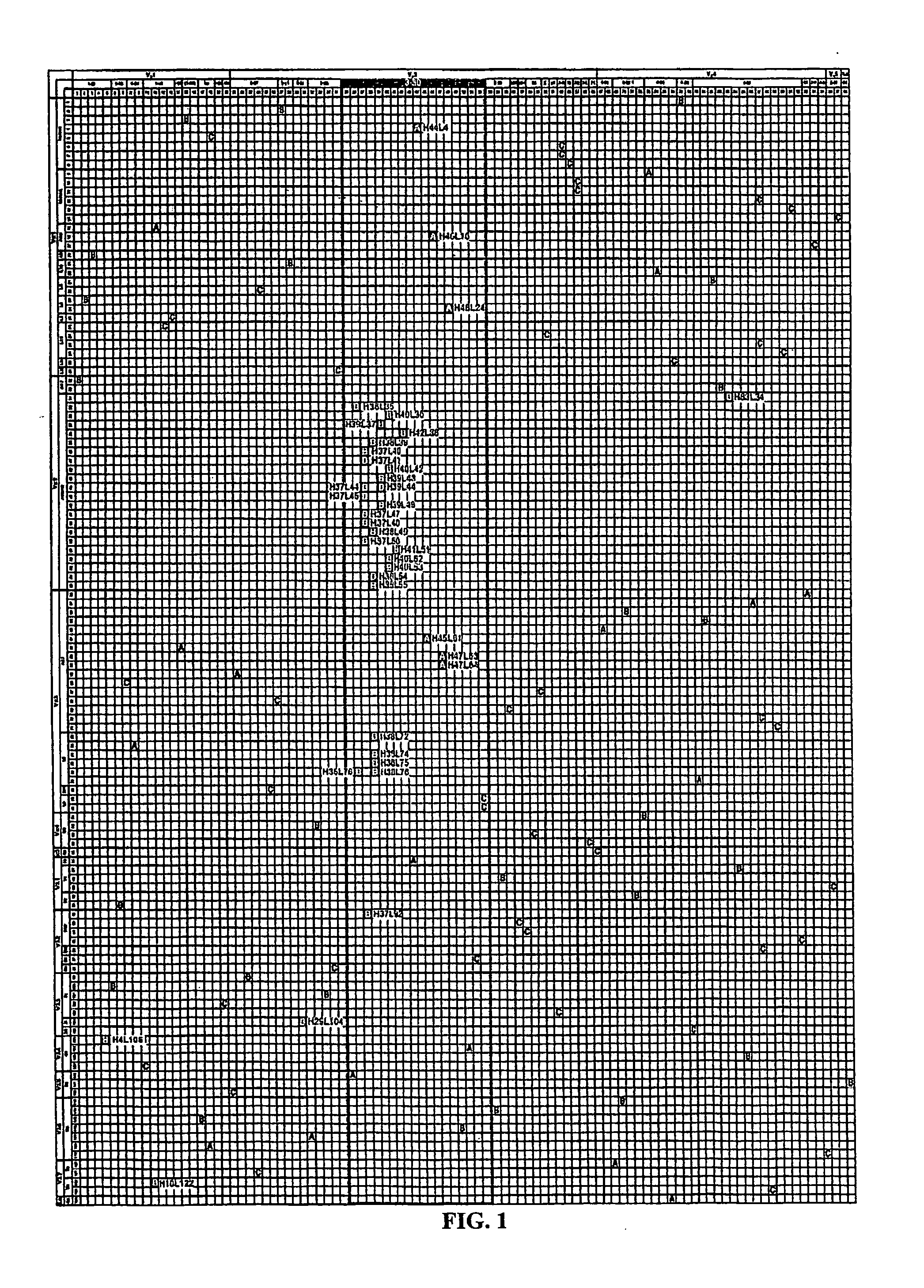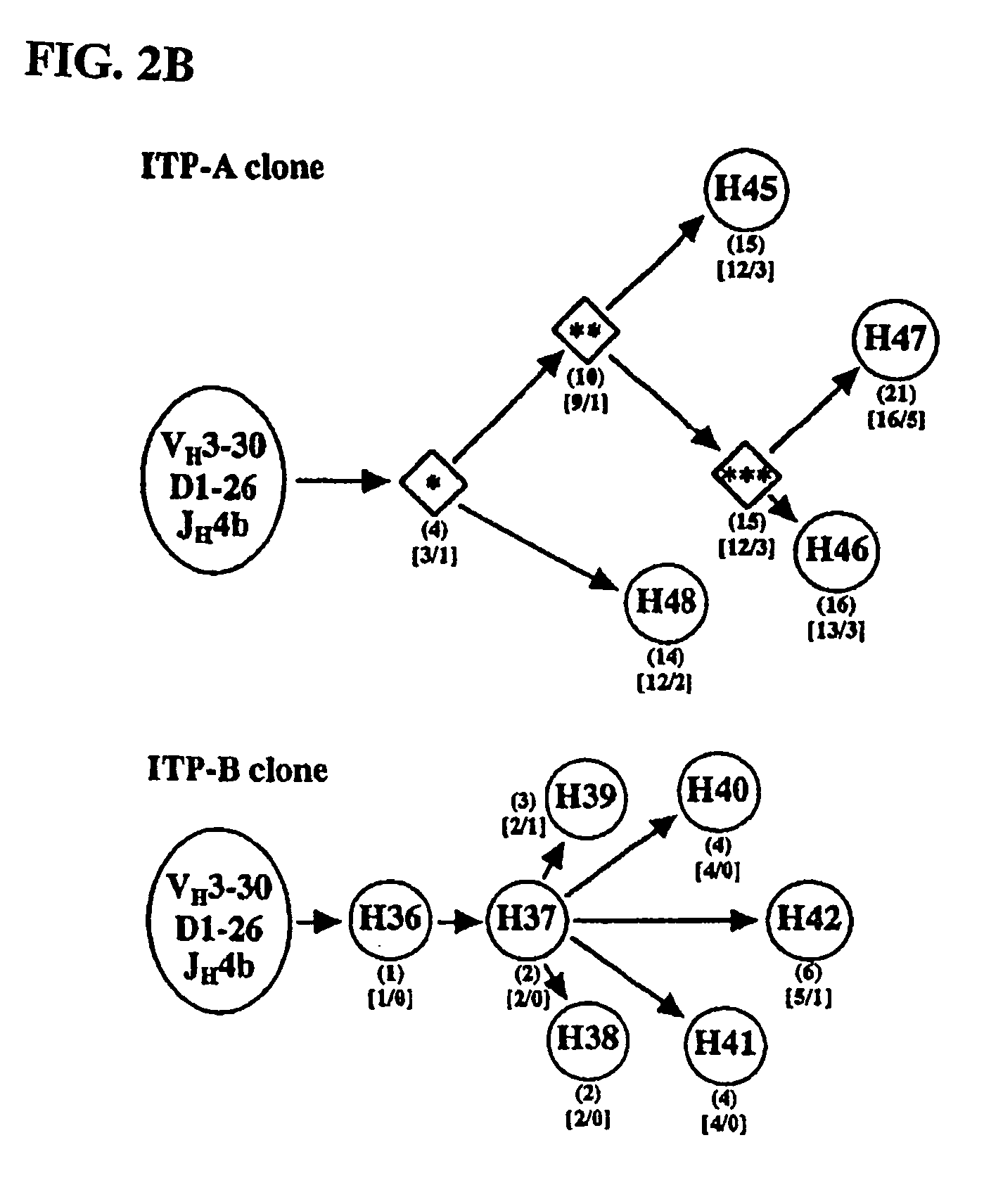Compositions, methods and kits relating to anti-platelet autoantibodies and inhibitors thereof
- Summary
- Abstract
- Description
- Claims
- Application Information
AI Technical Summary
Benefits of technology
Problems solved by technology
Method used
Image
Examples
example 1
Autoantibodies in Idiopathic Thrombocytopenic Purpura
[0369] Although idiopathic thrombocytopenic purpura (ITP) is the most common autoimmune hematologic disorder, little is known about the associated autoantibodies on a molecular level. Consequently, diagnostic assays and therapy for ITP lack specificity. To avoid technical limitations imposed by prior art B-cell immortalization methods, repertoire cloning (Fab / phage display) was used to clone platelet autoantibodies and examine the relation between immunoglobulin (Ig) gene usage, clonality, and antigen specificity. Phage display libraries were constructed from splenocytes from 2 patients with chronic ITP, and competitive cell-surface selection was used to isolate several dozen unique IgG platelet-specific autoantibodies. That is, antibody phage display, a molecular approach for cloning human immune repertoires (Siegel et al., 2001, Transfus. Med. Rev. 15:35-52), was combined with a novel competitive cell-surface-selection scheme (...
example 2
Peptide Inhibitors of a Human GPIIb / IIIa-Specific Platelet Autoantibody (H44L4)
[0410] Peptide phage display was used to define the epitope on platelet glycoprotein (GP)IIb / IIIa to which the human anti-GPIIb / IIIa monoclonal anti-platelet autoantibody termed “H44L4”, disclosed elsewhere herein, binds. Small molecule “peptidomimetics”, such as those which can be derived using peptide phage display technology, can assume the structure of conformational epitopes which would not only help map where on GPIIb / IIIa H44L4 binds, but can serve as leads for the development of infusible drugs that can inhibit the binding of such platelet autoantibodies in vivo.
[0411] Two different commercially-available peptide display libraries (commercially available from New England Biolabs, Beverly, Mass.) were used. These libraries, i.e., a “12-mer” linear peptide library and a “Cysteine-7-mer-Cysteine” (C7C) constrained peptide library, were used in sets of experiments in which H44L4 was the target. To a...
example 3
Epitope Mapping Studies
[0418] To assess where H44L4 binds on the platelet GPIIb / IIIa molecule (GPIIb / IIIa, an integrin molecule, is also referred to as αIIbβ3), H44L4 was incubated with a set of Chinese hamster ovary (CHO) cells expressing either αIIbβ3 or αIIb-αvβ3 chimeras in which a segment of αIIb (either amino acids 1-459, 1-223, 223-459, or amino acids 447-1009) was substituted for that portion of αv (αvβ3 is also a member of the integrin family and is known as the “vitronectin receptor”). These epitope mapping assays, and the chimeras, were described previously by McMillan et al. (2000, Brit. J. Haematol. 118:1132-1136). In those studies, McMillan et al., tested polyclonal patient sera or platelet eluates (H44L4 is the first human monoclonal autoantibody to platelets ever identified). McMillan et al., suggest that nearly all of the patient-derived polyclonal antibody material required the N-terminal portion of αIIb to bind.
[0419] For purposes of the epitope-mapping studies ...
PUM
| Property | Measurement | Unit |
|---|---|---|
| Adhesion strength | aaaaa | aaaaa |
Abstract
Description
Claims
Application Information
 Login to View More
Login to View More - R&D
- Intellectual Property
- Life Sciences
- Materials
- Tech Scout
- Unparalleled Data Quality
- Higher Quality Content
- 60% Fewer Hallucinations
Browse by: Latest US Patents, China's latest patents, Technical Efficacy Thesaurus, Application Domain, Technology Topic, Popular Technical Reports.
© 2025 PatSnap. All rights reserved.Legal|Privacy policy|Modern Slavery Act Transparency Statement|Sitemap|About US| Contact US: help@patsnap.com



